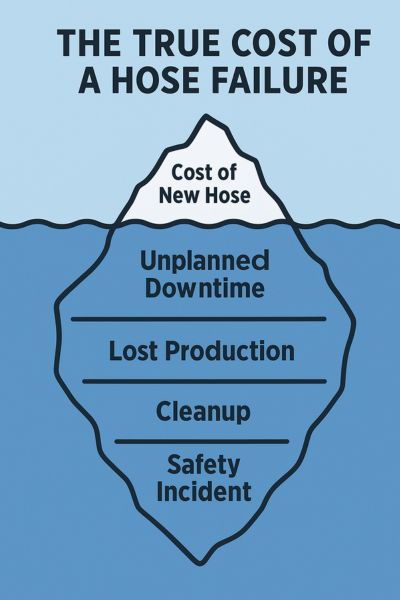Replacing hydraulic hoses too early wastes money; too late invites catastrophic failure and downtime. This expert guide provides a decision-making model to help you move beyond guesswork, balancing equipment safety with economic reality for optimal asset management.
The High Cost of Ambiguity in Hose Replacement
Deciding when to replace a hydraulic hose is one of the most consequential decisions in maintenance management. Replace it too late, and the results can be catastrophic. Replace it too early, and you waste time, money, and perfectly serviceable equipment. In both cases, the consequences reach far beyond the price of the hose itself.

The Unacceptable Risk of Failure
A hydraulic hose under pressure is not a benign component — it’s a potential hazard containing hot, high-pressure fluid capable of penetrating skin or causing severe burns.
When a hose bursts unexpectedly, the risks multiply:
- Personal injury: High-pressure fluid injection can cause permanent damage or amputation.
- Environmental contamination: A ruptured hose can release liters of oil, leading to costly cleanup and regulatory penalties.
- Collateral equipment damage: Escaping fluid can contaminate electrical systems or mechanical parts, compounding repair costs.
What begins as a single hose failure can quickly escalate into a safety incident, environmental violation, and operational crisis — all at once.
The True Financial Impact of Downtime
In industries such as mining, construction, or manufacturing, unplanned downtime is the real cost driver.
When a machine sits idle because of a failed hose, the financial impact can reach thousands to tens of thousands of dollars per hour, depending on production scale and contract penalties.
This downtime cost often exceeds the replacement cost of the hose by hundreds of times. The indirect effects — delayed deliveries, overtime labor, missed project deadlines, and reduced customer confidence — make reactive maintenance a far greater expense than proactive inspection and planned replacement.
Simply put, the cheapest hose is the one that never fails in service.
The Waste of Premature Replacement
On the other hand, replacing hoses too early — without evidence of degradation or data-driven scheduling — is equally inefficient.
Overly conservative maintenance policies can:
- Waste the remaining service life of hoses still performing safely.
- Inflate inventory and procurement costs by replacing components ahead of need.
- Consume valuable technician labor hours that could be focused on higher-risk systems.
Without condition-based data or inspection benchmarks, maintenance teams fall into the costly trap of “replace to be safe”, which drains budgets and creates unnecessary waste.
The Core Conflict: Reactive vs. Proactive Maintenance
Your hose replacement philosophy falls into one of two categories. The “run-to-failure” model is a reactive gamble, while a proactive strategy is a data-informed, controlled process that aligns maintenance with operational goals.
The “Run-to-Failure” Gamble
This reactive approach means taking no action until a hose fails in service. While it extracts the maximum theoretical life from each component, it guarantees 100% unplanned downtime and exposes the operation to the highest possible level of safety risk and collateral damage.

The Proactive Paradigm Switch
A proactive strategy uses data—from visual inspections, sensor inputs, and service history—to replace hoses just before they are predicted to fail. This converts unpredictable, high-cost emergency repairs into scheduled, low-cost maintenance events.
Shifting from a Cost Center to a Value Center
By adopting a proactive approach, the maintenance department shifts from being a cost center that only fixes broken assets to a value center that actively increases equipment availability, enhances safety, and improves the company’s bottom line.
Key Technical Indicators for Replacement Decisions
The foundation of proactive hose maintenance is recognition.
Every hose gives clear warning signs before failure — if you know how to read them. These technical indicators form the language of deterioration, helping maintenance teams make informed, timely replacement decisions.
External Cover Damage
The outer cover is the hose’s first line of defense against abrasion, weather, and chemical exposure. Any damage here is an early signal of internal risk.
Technicians should look for:
- Cuts or gouges: Signs of contact with sharp edges or improper routing.
- Blistering: Indicates fluid has penetrated beneath the cover, often from internal leaks or delamination.
- Severe abrasion or scuffing: A warning that the hose is rubbing against a surface and may soon breach.
- Weather checking: A fine network of surface cracks caused by ozone or UV degradation — evidence that the rubber has hardened and lost flexibility.
When the cover begins to degrade, it exposes the reinforcement layer to moisture and corrosion, accelerating the path to failure.

Exposed or Damaged Reinforcement
Once the steel wire or textile braid is visible, the hose’s integrity is already compromised.
Corrosion on exposed wires quickly weakens the structure, reducing burst pressure and making failure imminent. Even if the hose appears to function normally under pressure, the degradation is irreversible.
At this stage, replacement is mandatory — not repairable, not serviceable. Continuing to use a hose in this condition risks a sudden rupture, which can cause injury, contamination, and costly downtime.
Leaks at the Fitting or Along the Hose
Any sign of fluid weeping, seeping, or dripping around the hose body or crimped fitting must be treated as a failure indicator.
A leaking hose has already lost its seal integrity — a condition that cannot be fixed by tightening the fitting or applying sealant. In fact, retightening a crimped connection may worsen the damage by deforming the fitting or further stressing the hose body.
Leaks often point to internal reinforcement fatigue, cracked fittings, or degraded tube material, all of which are invisible until a full failure occurs. Replacement is the only safe response.
The Value of Early Recognition
Training technicians to recognize these symptoms early — and document them consistently — transforms maintenance from reactive to predictive.
Each inspection note, photo, or failure record becomes data that helps refine replacement intervals and improve overall equipment reliability.
A hose rarely fails without warning. Learning to identify those warnings is the key to preventing downtime, reducing costs, and keeping operators safe.
| Visual Indicator | Description | Recommended Action |
| Cover Cracking / Weathering | Fine, shallow cracks on the outer cover, especially on bends. The cover may feel hard and inflexible. | The hose is brittle. Schedule replacement at the next maintenance interval. |
| Blisters or Bubbles | A raised “bubble” on the outer cover, indicating a breach in the inner tube, allowing fluid to penetrate the layers. | De-energize the system and replace the hose immediately. Imminent burst risk. |
| Exposed Reinforcement Wire | The outer cover is scraped or worn away, and the steel braid/spiral is visible. | De-energize the system and replace the hose immediately. The primary burst defense is compromised. |
| Kinking or Crushing | The hose has been flattened or forced into a bend tighter than its minimum bend radius, restricting flow. | Replace immediately. The reinforcement is likely damaged, creating a high-stress failure point. |
| Leaking at Fitting Crimp | Seeping or dripping of fluid from the point where the hose meets the metal fitting shell. | Do not attempt to repair or retighten. Replace the entire assembly immediately. |
| Hose Age Exceeds Standard | Hose has been in service beyond the internal (e.g., 5-year) or industry-mandated replacement interval. | Plan for replacement. Even if it looks good, the elastomer properties have degraded over time. |
Calculating the Economic Indicators of Replacement
A purely technical assessment is only half the picture. For decision-makers, the economic analysis is just as important. Understanding the total cost of an in-service failure provides powerful financial justification for a proactive replacement program.

Beyond the Component Price Tag
The purchase price of a new hose assembly is a minor fraction of the total cost of a failure. A true economic analysis considers the much larger costs associated with the event, known as the Total Cost of Ownership (TCO).
Quantifying the Cost of Unplanned Downtime
Work with your operations team to assign a realistic dollar value to one hour of downtime for each critical asset. This figure ($X,XXX/hour) becomes the most powerful number in your replacement justification.
The Compelling Economics of Prevention
A planned replacement involves a known labor cost and zero downtime cost. An unplanned replacement involves emergency labor rates, potential overtime, plus the massive cost of lost production. The proactive approach is almost always cheaper.
The Replacement Decision Matrix: A Practical Tool
The optimal decision lies at the intersection of technical condition and economic consequence. This matrix provides a simple yet powerful framework for making consistent, justifiable replacement decisions across your entire fleet.
Defining the Matrix Axes
The vertical axis rates the “Consequence of Failure” as either High (critical machine, safety risk, high downtime cost) or Low (non-critical function, redundant system). The horizontal axis rates the “Hose Condition” based on the technical indicators from Section 3.
Operating Within the Four Quadrants
By plotting a hose on this matrix, the path forward becomes clear. A hose in poor condition on a high-consequence machine demands immediate action, while a hose in good condition on a low-consequence machine can be safely monitored.
Standardizing Your Team’s Response
Using this matrix as a standard operating procedure removes ambiguity and emotion from the decision. It empowers technicians and managers with a common language and a consistent logic for managing hydraulic assets, dramatically improving the accuracy of their judgments.
Request Your Consultation Today
Stop gambling with safety and profitability. Contact us today to schedule a complimentary consultation. Let us show you how a proactive, data-driven hose replacement strategy can transform your maintenance operation and deliver a measurable return on investment.
FAQ
What is a realistic service life for a hydraulic hose?
There is no single answer. It depends on the application, pressure cycles, temperature, and environmental factors. Many industrial standards suggest a 5-year maximum, but for severe applications, it could be as short as one or two years.
Can we reuse hydraulic fittings from an old hose?
Absolutely not. Reusing fittings is an extremely unsafe practice prohibited by all major standards bodies. Field-crimpable fittings are designed for one-time use; reusing them creates an unpredictable and unreliable assembly that is likely to fail.
If a hose looks perfect but is 7 years old, should I replace it?
Yes. While it may look good, the elastomer compounds inside have chemically aged and become brittle. The hose no longer has its original performance specifications and is far more likely to fail under pressure spikes or flexing than a new hose.
My supplier says their hose is “better.” How can I verify this?
Ask for data. A reputable manufacturer can provide technical specifications on ozone resistance, temperature ratings, and crucially, the results of standardized abrasion tests (like ISO 6945). Higher performance in these tests is a verifiable indicator of a longer-lasting cover.
How do I start implementing this decision matrix?
Begin with one or two of your most critical machines. Work with your operators and finance department to define the “Consequence of Failure.” Then, train your maintenance team on the visual indicators. Starting small makes the process manageable and proves its value quickly.
Does this strategy really save money if I’m replacing some hoses sooner?
Yes. The cost of one unplanned, catastrophic failure on a critical machine (including downtime, cleanup, and potential safety incidents) is often greater than the cost of proactively replacing hundreds of hoses. It’s about preventing the single massive expense.





